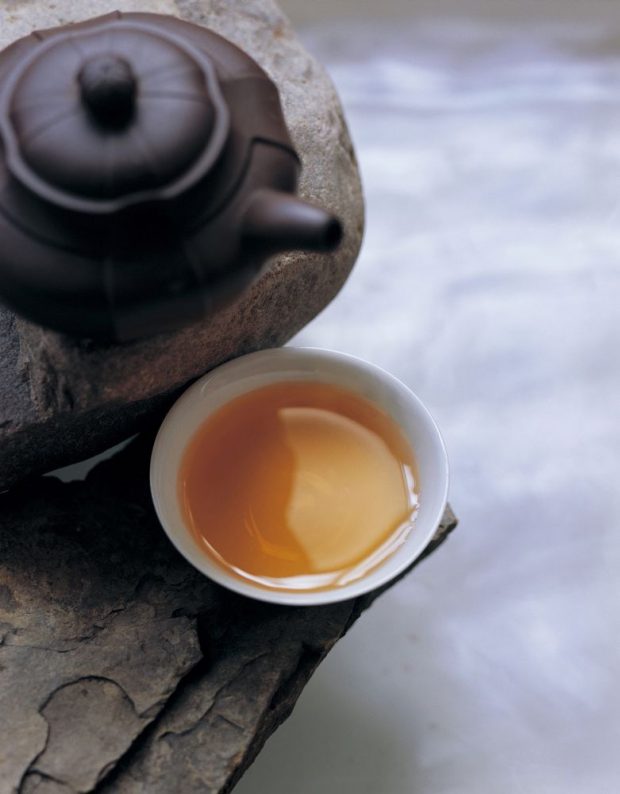‘Tea is essential part of Buddhist culture’
 Venerable Jiheo speaks of life with tea
Venerable Jiheo speaks of life with tea
Venerable Jiheo, 77, who has devoted his life to growing green tea plants since he became a monk at the age of 15, says the essence of Buddhist culture lies in tea. “A famous ancient book praising green tea says if one drinks seven cups of tea, that person can become a Buddha. With each cup of tea, one’s thirst, loneliness and complaints gradually go away. When the person reaches the seventh cup, he can feel the clear breeze blowing underarm with no wind at all,” said the former chief monk of Seonam Temple. He now runs a small temple Geumdun, just 14 kilometers south of Seonamsa (sa is Korean for temple), with some wild tea fields over 700 years old. “In practicing seon (zen), focusing on the single thought of hwadu, one’s body caves in to sleep and distracting thoughts. Teas help eliminate waste matter from the body, clear one’s mind and focus on the single subject of hwadu.”
The monk says Korean wild crafted teas, harvested in the traditional way by hand and roasted nine to ten times, are different from Chinese or Japanese teas. “Compared with China’s fermented green teas or Japan’s steamed tea, Korean green teas produced in the traditional way tend to have a deeper flavor. Repeatedly adding water to make more tea, the flavor and color is maintained from the first cup to the seventh.” Malananda, a Buddhist monk from Gandhara, in modern day Pakistan, brought Buddhism to the southern Korean Peninsula in the fourth century. He came to Baekje from Jin China in 384 and green tea was also introduced then. But as they were cultured in the terrain of the Korean peninsula, Korean wild green teas came to develop unique characteristics, different from green teas grown in the vast land of China or in the sea salt containing wind of Japan.
He describes the taste of Korean tea as like the blue sky in the fall. “Everybody falls in love with a clear autumn sky. For me, Korean tea’s taste reminds me of the clear blue autumn sky with some thin, wispy clouds floating in it,” he said. The Venerable Jiheo began his priesthood at Seonam Temple and has cultivated and made tea there for 25 years. At the age of 50, he left the temple to restore then abandoned Geumdun Temple, near Seonam Temple from 1990 until now. Living alone in Geumdun Temple, he “farms” around 6,600 square meters of wild tea trees, some that are up to 700 years old, and has planted tea plants on 33,000 square meters of land on a nearby hillside to preserve the Korean green tea tree breed. He says his wild tea plants are grown in the most natural ways that acknowledge their characteristics.
Japanese green tea plants are bred to make the roots stretch sideways to produce more tea leaves and planted in shallow ground. But, Korean wild green tea plants are deep rooted ― the roots are two to three times longer than the height of the plant, thus they don’t require fertilizers or pesticides, according to the monk. “The only maintenance they require is to give the plants the environment they love, but that is again not aimed to increase production. I cut over-grown branches and let the broad-leaved trees planted between green tea trees do the rest of growing _ giving the shade and wind required for growing green tea trees,” he said. However, those wild tea trees make up only 5 percent of all green tea trees within the county near Seonam, Geumdun and other small temples. 85 percent of all green tea trees, including those in famous green tea fields in Boseong, South Jeolla Province, are imported from Japan and are called yabukita.
Disappearing tea culture
With a coffee culture flourishing in modern day Korea, the monk laments people who feel closer to coffee than tea in their daily lives. Regarding the complicated tea ceremony that makes tea drinking like a ritual and deters the younger generation to try drinking teas, Ven. Jiheo says that this is “wrong-headed.”
“If teas are of great quality, the container holding the tea won’t matter. If tea is good, drinking it using a cracked gourd container doesn’t make the tea better or worse. What worries me more is that the tea culture may disappear altogether, not what ceremonies they should follow. I often joke that if people don’t drink tea lying down, any way of drinking it is okay,” the monk said. Jiheo says tea drinking works as a brake for a car running at full speed. “Everybody is running at full speed in chasing material wealth. Accidents can happen at any time. What can provide a break is one’s mind and culture, and tea helps people have a clear mind. “Also, when I said seven cups of teas are what is required to turn into a Buddha, it means that amount of conversation. Today, the majority of social ills comes from the lack of conversation between people including family members.”
About the New Year, the monk says the calendar makes people lazy. “Calendars fracture time into days and make people think that they have so many days ahead. But, people should realize that they are growing old each moment and they can get sick and die in any moment. Then we can ask ourselves what we want and can do before our death. With a clear mind, we should be able to look at the path we are taking in our life,” he said.
By Park Jin-hai
(Korea Times)
























































